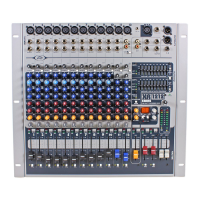
Do you have a question about the Peavey XR 1212 and is the answer not in the manual?
| Brand | Peavey |
|---|---|
| Model | XR 1212 |
| Category | Music Mixer |
| Language | English |
Alerts users to dangerous voltage, shock risks, and fire hazards from exposure to rain or moisture.
Highlights important operating and maintenance instructions provided within the literature.
Lists the main features of the XR 1212 and XR 1220 mixing consoles, including DSP, effects, and amplifiers.
Specifies the necessary clearance for proper ventilation of the mixing console.
Details the balanced XLR input for microphones and 1/4" line inputs for keyboards/CD players.
Explains the use of TRS insert jacks and the gain control for setting channel input levels.
Covers switches for selecting mic or line/MP3 inputs on specific channels.
Describes the 80 Hz low-cut filter and the high EQ (treble) control for adjusting brightness.
Details the Hi Mid-Morph, Low Mid, and Mid EQ controls for shaping mid-range frequencies.
Explains the low EQ control for adjusting bass and its caution regarding power consumption.
Covers controls for routing signals to monitor outputs and the effects bus.
Describes the pan control, mute button, clip indicator, and signal presence LED for each channel.
Details the 60mm level fader for controlling the channel output level.
Explains the PFL switch and introduces master section features like graphic EQ.
Describes the switch for selecting main operating modes and output configurations.
Introduces the Auto EQ feature for improving sound quality and reducing feedback.
Explains the built-in crossover for subwoofers and the benefits of high-pass filters.
Details the Feedback Ferret system for automatic acoustic feedback elimination.
Explains how to set up microphones and connect for Auto EQ tests.
Outlines the steps for running the Auto EQ test for system optimization.
Describes the meaning of LED indicators for Auto EQ test success or failure.
Provides guidance on identifying and correcting issues during the Auto EQ test.
Covers the main L/R faders for output level and the LED meter array for signal strength.
Details the monitor output level controls, faders, and their assignment to internal amplifiers.
Explains monitor clip/mute LEDs, signal LEDs, mute switch, and AFL function.
Describes the effects send jack, mono/sub output jack, and headphone output jack.
Covers controls for effects return level, clip/mute LEDs, signal LEDs, and mute switches.
Introduces the DSP-based effects processor, its capabilities, and parameter control.
Details using the encoder and display to select and adjust effect presets.
Explains the tap delay feature for setting delay times using a footswitch or button.
Lists available presets for Reverbs, Delays, Parallel Reverb/Delay, Tap Delay, and Chorus.
Describes how to save custom effect settings into user storage locations.
Covers the main power switch and the EFX Peak LED for headroom indication.
Details the IEC inlet for power and Neutrik Speakon/1/4" phone connectors for speakers.
Provides detailed input impedance, gain settings, and input levels for XLR and Line inputs.
Lists output levels, load impedance, and connector types for various outputs.
Details gain ranges, channel EQ specifications, and frequency response.
Covers THD, EIN, crosstalk attenuation, and common mode rejection ratio.
Outlines power output ratings, load impedance, and connection types.
Provides physical dimensions and weight for the XR 1212 and XR 1220 models.
Illustrates the internal signal paths and component connections within the mixer.
Details what is covered, what is not covered, and who is protected by the warranty.
Explains how to obtain service and outlines limitations on implied warranties.